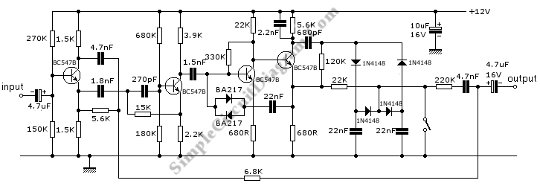Philip’s Dynamic Noise Limiter
When there is quiet passages, a tape noise becomes disturb. This noise can be reduces using Philips’ Dynamic Noise Limiter circuit. The principle operation of this circuit is improve the signal-to-noise ratio during the quite periods by decreasing the gain for the higher frequencies. However, on the higher frequency components of the signal, the effect is not significant because the noise mask these frequencies. When the signal level falls, the high-frequency attenuation increase as well. For example when the input falls to 2mV the the attenuation rises to 20 dB at 10 kHz and 10 dB at 7.5 kHz. This circuit has effective roll of 18dB/octave. Here is the circuit:
The input level must correct because the amount of high-frequency attenuation depends on the input signal level. A ‘line level’ should be generated at the input by the driving circuit. A sinusoidal source and a ‘scope can be used to test this circuit. For tape use, record 1 kHz sine wave at 100% modulation and then check the level at the input of the DNL. To adjust the amplitude of the input to the correct level, a potential divider can be used. The component values shown in the schematic diagram is similar with Elector magazine version, but with capacitor (22 nF) and diodes (BA127) included as limiter as we can see in Wireless World publication. [Circuit’s schematic diagram source: http://graffiti.virgin.net/ljmayes.mal/]